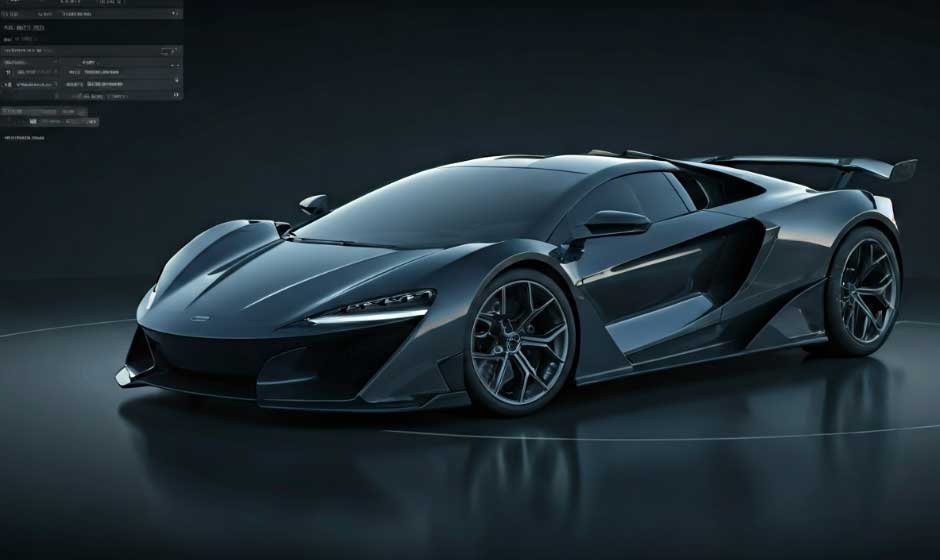Skip to the good bit
ToggleKey Highlights
- Discover how 3D car modeling transforms automotive industry workflows, enabling precise designs and effective development processes.
- Learn about the significance of intricate details and rendering techniques in achieving realistic vehicle representations.
- Explore critical steps, from conceptualization to the final product, ensuring precision and consistency throughout the modeling journey.
- Understand the role of advanced tools like Autodesk Maya and Blender in simplifying the production pipeline.
- Investigate the versatility of 3D car modeling for applications spanning game development, films, and architectural visualizations.
Let’s dive deeper into the fascinating realm of automotive design and cutting-edge 3D car modeling techniques!
Introduction
3D Automotive modeling is important in automotive design. It brings new ideas to areas like game development, films, and making cars. This field uses both creativity and new technology. Many modelers use these tools to make cars look real in the digital world. They can show every detail with great precision. The cars made through 3D modeling end up in video games or ads, where people can see them from all angles. Each team works step by step, so the cars look just right.
Let’s look at the main points, tools, and ways people do 3D car modeling in today’s world.
Foundations of 3D Car Modeling
Making great 3D car models starts with having good foundations based in consistency and precision. The 3d car designer need to do the work with care to be sure every part fits industry standards. The focus on detail is what makes digital cars look realistic.
But it’s not just about the technical side. Top modelers also follow reliable ways of working. They use clear steps, starting at the first sketches and going all the way to the final rendering. This system helps the car look nice and work well in the end. When you build your process this way, it helps you use advanced tools and try out new ideas too.
Key Concepts and Terminology in 3D Vehicle Design
The language used in 3D vehicle design is important for good and effective communication in the whole pipeline. This starts with sketches and ends at rendering. Automotive designers use certain words together, which helps everyone work towards the end project. Words like “polygon count” and “UV mapping” help people understand the model’s structure in a simple way.
To work as a team, it is key to know “mesh topology.” This is about how polygons are lined up. When you get this right, models keep their shape and do not lose form, even with changes. Keeping this consistency helps teams take less time on fixes and spend more on the intricate details of each design. Good workflows make the development process easier for everyone.
A word called “rigging” comes up a lot in animation and video games. Rigging helps put in strong, bendy parts, which means vehicles can show real-life movements as they go. This gives the design great functionality. Learning and using these main terms can help teams have a smoother pipeline, better animation, and 3D vehicle design that stands out.
Essential Software Tools for 3D Automotive Modelling
Professional tools help you get the best out of 3D car modeling. Each tool brings its own set of features to help modelers reach great results. The most used programs are Autodesk Maya, Blender, Cinema 4D, and ZBrush. These are well known for their strong rendering, smooth animation, and spot-on precision in design.
| Software | Specialization |
| Autodesk Maya | Made for animation-driven modeling and perfect for designs with intricate details. |
| Blender | Open-source with functionality that covers the whole 3D pipeline. |
| 3ds Max | Great for models with lots of polygons and texture work. |
| Cinema 4D | Has a simple look and feel, built for broad and clear visual rendering. |
| ZBrush | Stands out when you want to sculpt intricate details and natural textures. |
The best tool for your project depends on things like what type of 3d game animation and movie animation you need, how well the tool will work with other software (compatibility), or how much realism you want. Each of these programs helps modelers build high-quality final products that really stand out.
Core Techniques Used in 3D Car Modeling
Great 3D car modelling uses methods that balance how well something works with how real it looks. For video games, many people use low-poly modeling. This makes sure the models work well and you do not lose any performance, helping with system compatibility and fast gameplay.
On the other hand, things like sculpting fine surfaces help to add more life-like touches. This is very important in film and advertising projects where people want high realism. When you add in textures—like those that look like leather seats or car paint—that can make the digital cars look even more real. By using these ways of creating cars, people can meet what the industry needs. This also gets them ready to look into more types of modeling for their projects.
Polygonal Modeling vs. NURBS: Methods and Applications
Both polygonal modeling and NURBS be good for different uses. You need to know when to use each one, so you get the best out of your development process. With polygonal modeling, you break a shape into many small pieces called polygons. This gives you a lot of control over both the shape and the look of your work. It helps a lot in game development, as it has good compatibility with low-poly work.
NURBS stands for Non-Uniform Rational Basis Spline. It lets you make very smooth and exact curves, which is great when you need precision, like for cars. NURBS is good when you must build soft lines or round parts, such as headlights or the roof of a car.
It is clear that polygonal modeling fits better if you want realism for games or movies, since the look is so important. But if your development process is about building strong, working vehicles, then NURBS gives you the functionality you need. Picking the right one for the job can help get both realism and good use in your project.
Sculpting Details & Creating Realistic Surfaces
Adding intricate details is key when you want to build lifelike vehicles. You have to use things like subdivision modeling to smooth out edges and make body surfaces better. Designers can use this to put in dynamic details, just like you see on real luxury cars from Ferrari and Porsche. This way, the method slices big shapes into smaller parts, making the car look closer to the real thing.
Artists also use texture mapping to show off real surfaces, making sure what you see, like the paint and chrome highlights, look just like their real Ferrari or Porsche version. For example, shiny reflections on a Ferrari hood give it more style, and you notice the detail on a Porsche’s tailpipe for how good it looks. These models then get put through rendering to get the right effects on how light and shadow work.
The rendering touches help give off a real feel, so the final product not only looks cool but works well, too. Adding these high-level details goes a long way, and is great for those working in things like ads and making movies where they want top realism and good functionality.
Conclusion
In the end, going into 3D car modeling lets you tap into the world of hands-on creativity and technical skill. When you learn the basic ideas and figure out the main software tools, you will see what you can make and also how to do it. With some practice, you can use the key steps to turn your own ideas into amazing pictures. When you shape intricate details or try different ways of modeling, the experience can be hard but also very rewarding. To make good and real-looking 3D car models, you will need to keep practicing and have patience all the time. If you want to get better or need help, you can book a free consultation now to get tips made just for you from our team of experts.
Frequently Asked Questions
What software is best for beginners in 3D car modeling?
Blender is a good choice for people who are new to 3D car modeling. It is open-source, so it is free to use. Blender can do many things, like animation, and it works with many file formats. You can use it in different ways to make great looking final products. Autodesk Maya has more advanced tools and is used by many professionals. But it can be harder to learn at first.
How long does it take to model a realistic car in 3D?
Making a realistic car in 3D takes time and depends on how hard the development process is. Skilled modelers might spend anywhere from 100 to 300 hours as they work for precision and focus on intricate details. They also work to get good rendering. The time it takes can change based on what the automotive design needs and the size of the project.
What are the most common challenges in 3D car modeling?
Some challenges are to keep consistency in the designs, handle the pipeline, and pay attention to intricate details so the work has more realism. It can be hard to balance how well it works with how good it looks. This becomes even more tough when you are working on big and complex projects.
Can 3D car models be used in both games and films?
Yes, 3D car models work well in both video games and films. When you use the right rendering and make sure there is good compatibility, the same models can be in video games or look amazing in movie scenes. People often use them in game development, where they might be a game asset or part of the animation.
Are there free resources or tutorials for learning 3D car modeling?
Resources like Blender give you lots of free tutorials that help people learn low poly modeling and build things like car model features. With these guides, you also get tips about how to use good and effective communication when working on a project. If you want to learn even more, Autodesk Maya has strong advanced learning tools for anyone who wants to get better at making a car model. Both Blender and Autodesk Maya let you learn, work well with other people, and try new ways of modeling.







